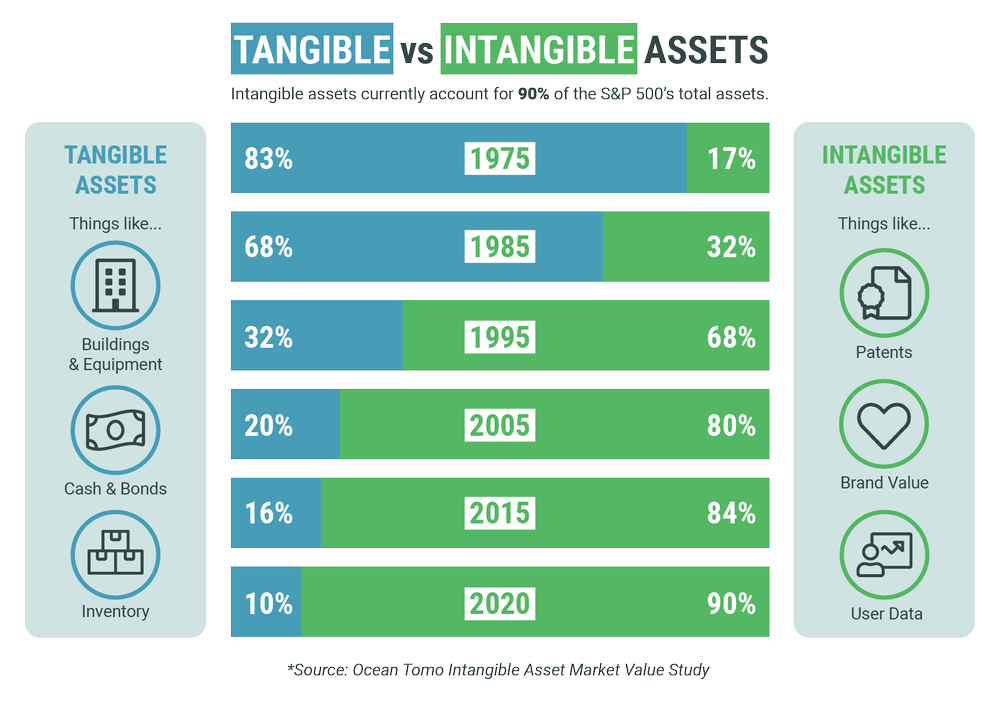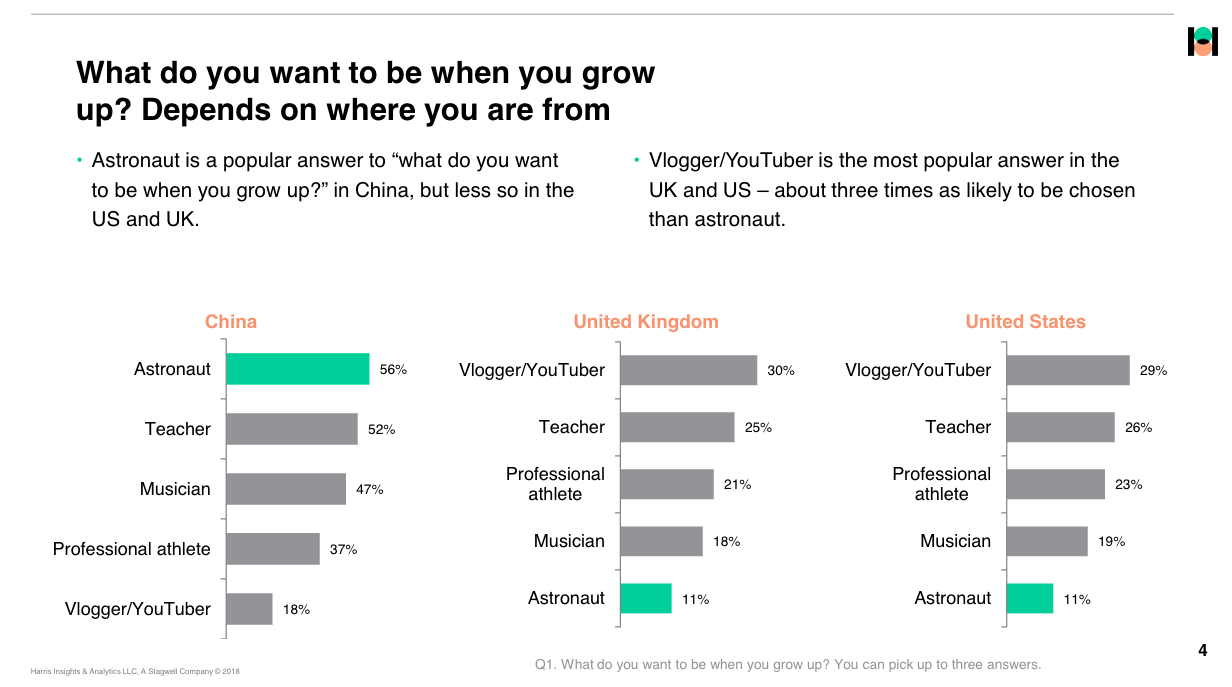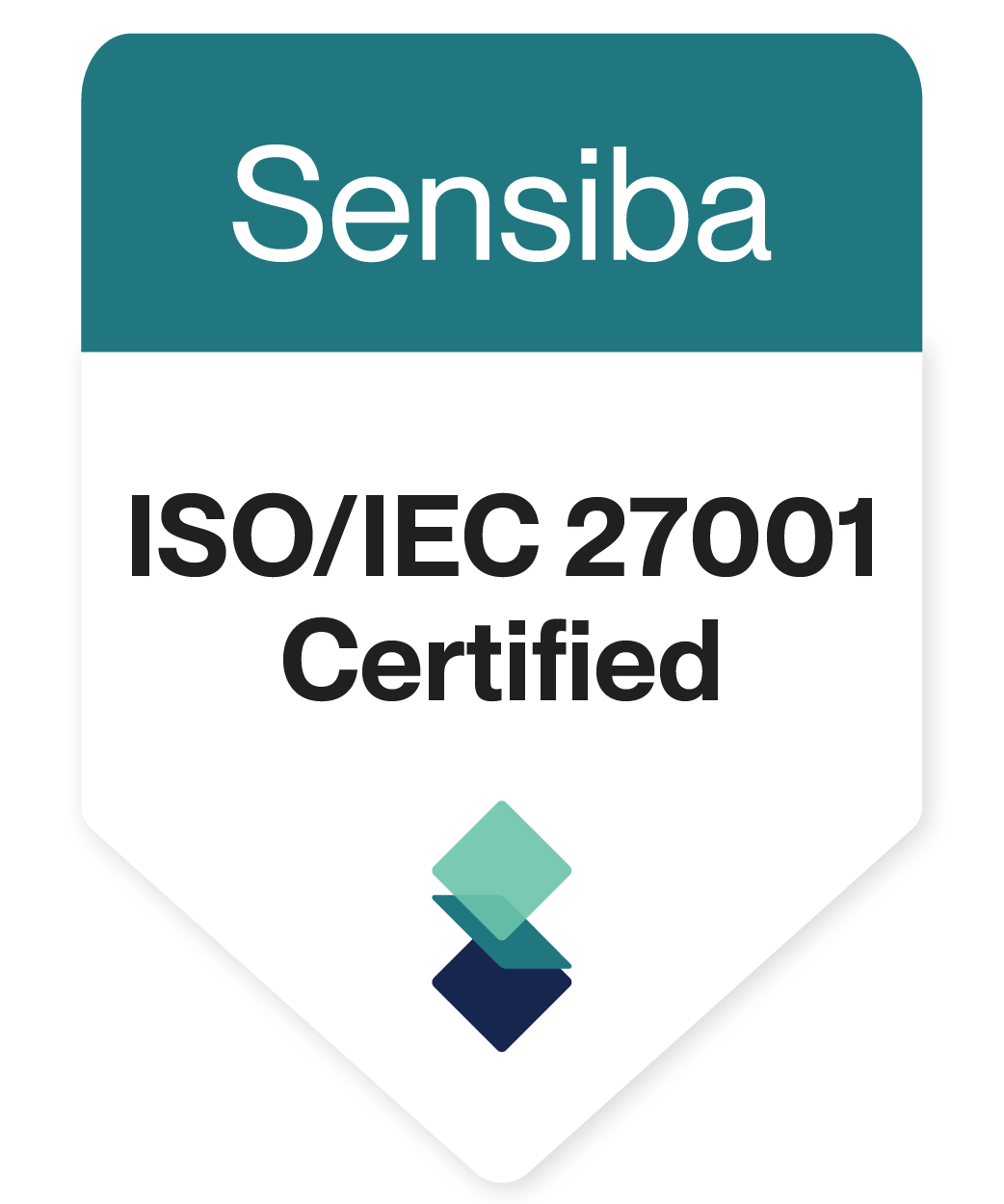I recently read the book Super Communicators by Charles Duhigg. This is a must-read for anyone who cares about building people skills in any organization.
It’s a timely topic, given the fast move toward and adoption of AI technologies that is swinging the focus of skill building in organizations away from “hard skills” like software development and accounting, which can increasingly be replaced by AI, to skills that are a unique reflection of our human-ness.
As automation reshapes entire industries, technical expertise is no longer the only differentiator. The skills that will define the next era of leadership and collaboration are deeply human: the ability to connect, to listen, to navigate complexity in conversation. These are the skills AI can’t replicate—and the ones organizations can’t afford to overlook.
LinkedIn recently released its fastest growing skills of 2025, and among the top 10 are skills that directly relate to our ability to communicate and connect with others:
- #2 – Conflict Mitigation
- #6 – Public Speaking
- #7 – Solution-Based Selling
- #8 – Customer Engagement and Support
What do these have in common? They all rely on a person’s ability to read the room, build trust, and adapt how they communicate in real time. These aren’t just traits—they’re skills that can be developed and strengthened.
At Cloverleaf, we believe technical skills will keep evolving, but human connection is the constant that drives collaboration, trust, and performance. And the good news is: it’s not something you’re either born with or not. It’s something you can practice daily.
Get the free guide to close your leadership development gap and build the trust, collaboration, and skills your leaders need to thrive.
What Super Communicators Understand About Human Connection
While there are many concepts, ideas, and resources in Super Communicators, I wanted to highlight a couple that often go overlooked—and that Cloverleaf has been specifically designed to support.
Duhigg’s core idea is simple but powerful: great communication isn’t about being the loudest voice in the room or the most charismatic. Super communicators aren’t born—they’re made. What sets them apart is their ability to prepare intentionally, stay curious in conversation, and create connection through active listening.
These are not vague soft skills. They’re specific behaviors backed by research. And more importantly, they can be practiced.
Our platform helps individuals and teams turn these habits into part of their daily workflow through calendar-based meeting prep, tailored coaching prompts, and reflection tools that support better conversations in real time.
When communication becomes a habit, connection becomes a competitive advantage.
Make Team Development More Impactful
See How High Performing Teams Use Tech To Equip Their Leaders

Preparation: The Underused Power Skill
One key aspect of becoming a super communicator is preparing well for meetings and conversations with others. Duhigg highlights the importance of setting yourself up with a curious mindset—one that’s ready to ask questions and learn before pushing an agenda or selling an idea.
We are well served to do a bit of prep work before a dialogue begins. Researchers at Harvard and other universities have looked at exactly which kind of prep work is helpful.
Participants in one study were asked to jot down a few topics they would like to discuss before a conversation began. This exercise took only about thirty seconds; frequently, the topics written down never came up once the discussion started. But simply preparing a list, researchers found, made conversations go better. There were fewer awkward pauses, less anxiety, and afterward, people said they felt more engaged.
This isn’t just good advice—it’s a repeatable practice. The best conversations start before the meeting even begins.
Cloverleaf makes this prep work easy.
When you connect your calendar to your Cloverleaf account, you receive a daily digest delivered directly to your inbox each morning. It includes personalized insights to help you prepare for the people you’re meeting with—like knowing a teammate prefers direct communication, or that a collaborator is energized by brainstorming. That kind of insight can shape how you approach a conversation and dramatically improve how your message is received.
Great communicators are prepared communicators—and that starts with emotional intelligence and a thoughtful understanding of how others think and interact.
You can learn more about all the great meeting insights and preparation features Cloverleaf offers by viewing our help doc here.
Listening: The Shortcut to Real Connection
It’s not enough to simply prep well for a conversation or meeting. To create meaningful connection—and drive better outcomes—you also need to listen with intention.
Duhigg dedicates a chapter to this idea, exploring the power of asking emotionally resonant questions that build connection. He shares the story of a husband-and-wife research team that brought strangers together to test different theories for forming connection and found:
There was only one method tested that could reliably help strangers form a connection: a series of 36 questions that elicited ‘sustained, escalating, reciprocal, personalistic self-disclosure.’
The key was creating vulnerability that led to emotional syncing—or emotional contagion.
This kind of connection doesn’t happen by accident. It comes from listening not just to respond, but to understand. Super communicators ask questions that invite reflection. They create space for others to feel seen, heard, and valued. That’s what builds trust—and drives real collaboration.
That insight is central to why we added discussion questions as a tool for team building in the Cloverleaf dashboard. Not every prompt is designed to surface deep vulnerability, but they are built to foster meaningful connection. And after reading Super Communicators, we even added a few new ones—see if you can spot them.
At Cloverleaf, we believe connection is built through small, intentional moments. When people feel heard, they engage more deeply with their work, their teammates, and their purpose.
Making Communication a Daily Habit
Super Communicators makes the case that great communication isn’t a personality trait—it’s a pattern of behaviors anyone can build. But even the most powerful insights fade if they aren’t applied when they matter most.
And that’s the real challenge: how do you keep practicing these skills when work gets messy, fast, and unpredictable?
Cloverleaf doesn’t teach you how to communicate in theory—it helps you show up differently in the moments that count. Right before a tough conversation. In the middle of team tension. When you’re preparing for a meeting, and realize the way you like to communicate might not be how they best receive information.
For example:
- After reading Duhigg’s advice on listening, you might recognize a moment in your daily digest where a teammate values emotional insight over data, and suddenly, the tone of your check-in shifts.
- A discussion prompt pops up that mirrors the 36 questions research—not to push vulnerability, but to spark the kind of connection that makes future feedback easier.
- Or maybe you see a coaching tip that reminds you to pause and ask a question instead of jumping straight to a solution.
These are small, human moments. But they’re where communication skills take root. Not in theory, but in practice. Not once, but repeatedly.
Because the future of work doesn’t need more communication training. It needs more communicators who know how to practice what matters—day by day, conversation by conversation.
What Could Shift if You Started With Curiosity?
Communication often breaks down not because people lack information, but because they’re missing perspective. We rush to solve, defend, and persuade. But what if we started with a different goal?
What if the next conversation wasn’t about being heard, but about understanding someone else more fully?
The research in Super Communicators makes this clear: the quality of our communication depends less on what we say and more on how we show up. With curiosity. With intention. With a willingness to prepare, to listen, and to connect.
That’s not just a personal skill—it’s a team advantage. One that deepens trust, strengthens collaboration, and unlocks better outcomes across the board.
So here’s the question this article leaves us with:
What might change in your team, your culture, or your leadership—if curiosity became your default starting point?
Understanding the unique capabilities each employee brings to the table and the areas where they may require support is not just about filling gaps or enhancing performance. It’s about creating a dynamic and adaptable workforce that can meet the challenges of today’s fast-paced business environment.
When employees know their strengths, they can leverage them to contribute more effectively, increasing job satisfaction and productivity. Conversely, identifying and managing weaknesses can prevent potential pitfalls and enable a proactive approach to career development.
The essence of this article is to explore the nuanced art and science of discerning and developing diverse talents within a workforce. We will delve into strategies for identifying strengths at various stages of the employee lifecycle, the importance of addressing weaknesses constructively, and how to integrate this knowledge into robust development plans.

Evaluating Employee Performance: The Strengths vs. Weaknesses Debate
A pivotal question arises in talent management: Should leaders amplify employee strengths or dedicate efforts to remediate weaknesses? The debate is rich with varying perspectives, each backed by its own set of principles and outcomes.
The Reason For Developing Strengths
Advocates for a strengths-based approach, such as those posited by Gallup’s research, suggest that focusing on what team members naturally do best can lead to higher employee engagement, increased productivity, and greater profitability.
Dr. Donald O. Clifton’s work in positive psychology underpins this strategy, emphasizing that when individuals apply their core strengths, they are more likely to excel and remain motivated. For instance, a salesperson with a natural charisma may be encouraged to harness this trait to foster better client relationships, thus driving sales.
The Necessity Of Addressing Weaknesses
Conversely, proponents of developmental focus, drawing upon the work of renowned psychologist Carol Dweck, argue for the growth mindset’s potential to transform weaknesses into competence areas. The rationale is that neglecting weaknesses, especially those that hinder performance, can harm individual and team success. For example, a project manager struggling with time management could benefit from targeted skill development, as this weakness directly impacts their core responsibilities.
Applying A New Approach To Strengths And Weaknesses
The nuanced truth may lie in a blended approach that acknowledges the multifaceted nature of our development strategies. As Marcus Buckingham says, A strength is not what you are good at, and a weakness is not what you are bad at. A strength is an activity that strengthens you. It draws you in, makes time fly by while you’re doing it, and makes you feel strong.
Of course, we want people to leverage their strengths, but when developing their weaknesses or opportunities for growth would directly impact their role, performance, and career development, it only serves the individual, team, and organization to strengthen areas in need.
This perspective underscores the benefits and importance of aligning employee roles with their strengths while strategically developing weaknesses that limit their potential. It’s not about a binary choice between strengths or weaknesses but rather an awareness of both, ensuring that employees are positioned to excel while evolving in areas that contribute to their role’s demands and career trajectory.
Do we need to force a person to develop the ability to design great presentations when it’s not essential to their role or future within the company? Probably not. But it would serve them to improve their active listening, ability to give feedback or overall communication skills. Those interpersonal skills are role and function-agnostic.
The debate is not about choosing one approach; it’s more advantageous to foster a robust and adaptable workforce intentionally. Organizations can create a continuous growth and resilience culture by leveraging strengths and judiciously improving upon weaknesses when necessary.

Do You Want To Unleash The Strength's Of Your TEam?
Find Out How To Quickly:
- Make development available to each team member
- Personalize growth to individual strengths and needs
- Integrate learning so it is actually in the flow of work
- Scale human skills that accelerate teamwork
- Prove the ROI of your development programs

How To Identify Employee Strengths And Weaknesses
Understanding and leveraging employee strengths is a cornerstone of effective talent management. Strengths are more than tasks an employee excels at; they are activities that invigorate and inspire, leading to peak performance and job satisfaction.
4 Strategies for Uncovering Strengths:
1. Interview Process: Begin at the recruitment stage by asking candidates to articulate their strengths as they pertain to the role. Inquire how they’ve previously harnessed these strengths professionally, which can offer predictive insights into their future performance.
2. Onboarding Observations: The initial months of employment are telling. Observe which tasks new hires gravitate towards and excel in, and note any hesitancy or reluctance in other areas. This period is ideal for identifying natural aptitudes and potential areas for growth.
3. Ongoing Dialogue: Regular one-on-one meetings between managers and employees should be a platform for discussing strengths. Encourage employees to reflect on their successes and how they can apply their strengths to current and future projects.
4. Performance Reviews: Incorporate self-assessment in performance evaluations to prompt employees to consider their strengths critically. Goal setting should then align with these strengths, fostering a sense of achievement and progress.
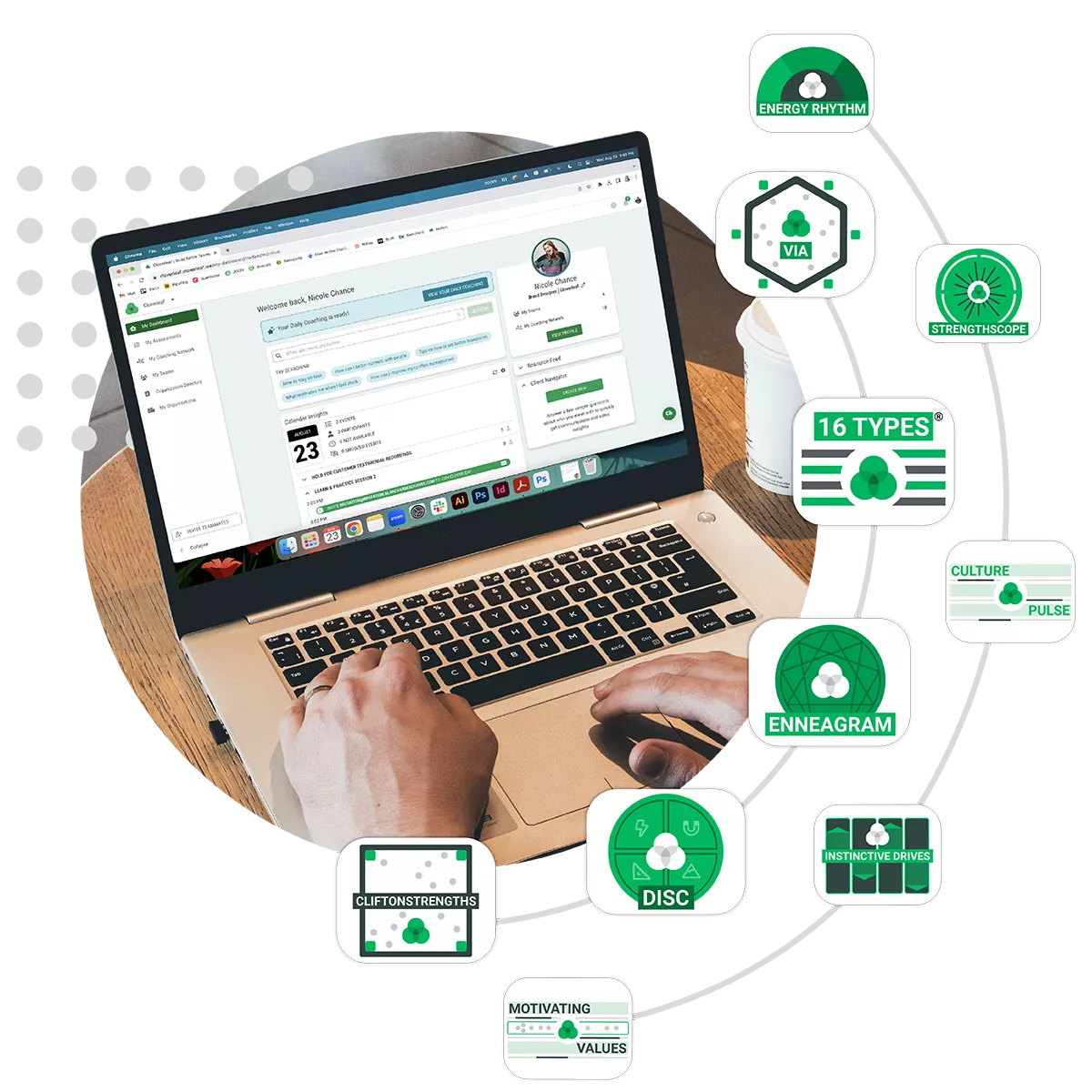
The Role of Psychometric Assessment Tools:
Psychometric tools such as the 16 Type Indicator (MBTI), DISC, and CliftonStrengths® offer valuable insights into an employee’s strengths. These assessments can help increase self-awareness and guide personal development, ensuring each member’s strengths are fully utilized.
Cloverleaf takes the insights from traditional assessments and transforms them into actionable coaching. By integrating Cloverleaf’s insights into daily workflows, managers and employees can have more strategic conversations about performance and development, leading to a more engaged and productive workforce.
Recognizing Employee Weaknesses
In a professional context, weakness is an area where an employee may lack proficiency, impacting their performance or growth potential. Identifying these areas is not about highlighting shortcomings but about fostering an environment of continuous improvement.
3 Methods for Uncovering Areas for Development:
1. Candid Feedback: Create a culture where feedback is seen as a tool for growth. Encourage managers to provide candid feedback to help employees understand their development areas while supporting them.
2. Self-Assessment: Empower employees to self-reflect on their performance and identify areas they wish to improve. This self-directed approach to professional development can lead to more meaningful and personalized growth paths.
3. Integrate Coaching: Foster a coaching culture where leaders facilitate employee development, empowering individuals to identify and develop their strengths and address growth areas in alignment with organizational objectives.
Addressing weaknesses should be a supportive process that aligns with the employee’s career aspirations and the organization’s goals. Employees can approach their weaknesses as opportunities for growth and learning by focusing on development rather than deficiencies.

Harnessing Strengths and Addressing Growth Opportunities in Employee Development Plans
With a clear understanding of personal strengths and areas for growth, the next step is to integrate this insight into a cohesive development strategy. Organizations thrive when they establish systematic processes that recognize and harness individual strengths and constructively address and support growth opportunities.
Incorporating this dual focus into performance evaluations and career pathing plans is crucial. Such an approach ensures that development is not a one-size-fits-all program but a tailored journey that aligns with each individual’s unique capabilities and aspirations.
4 Ways Employees Can Advocate For Their Strengths and Development
Proactive communication and feedback are vital for individuals to leverage strengths and identify growth opportunities. Here’s how to effectively engage in this process:
1. Practice Good Communication: Discuss your key strengths with your manager, ensuring they know where you excel and how to utilize them. This transparency can help prevent burnout and lead to more fulfilling and suitable projects.
2. Be Self-Motivated: Actively seek out and express interest in projects that align with your strengths. Request that your manager keeps you in mind for upcoming opportunities that match your skill set, allowing you to contribute effectively and grow within the organization.
3. Welcome Feedback for Growth: When challenges arise, approach your manager for constructive feedback. Collaboratively set realistic and measurable improvement goals in areas causing stress or difficulty. This approach not only aids in personal development but also demonstrates your commitment to professional growth.
4. Integrate Continuous Learning: Take ownership of your development by seeking resources such as articles, books, and training sessions to sharpen your existing strengths and help you develop new skills. Attend conferences and engage in experiences that broaden your perspective and enhance your competencies.
9 Key Practices for Managers to Optimize Team Strengths
For leaders, the art of nurturing employee growth is both a responsibility and a privilege. Here’s a roadmap to best practices in this endeavor:
1. Utilize Development Frameworks: Engage with established performance and career development frameworks already available.
2. Integrate Development into Dialogues: Ensure that discussions of strengths and growth areas are a staple of one-on-one meetings. This consistent focus helps to personalize development plans and reinforces the importance of continuous improvement.
3. Celebrate Successes: Regularly recognize and celebrate achievements in both individual and team settings. This can boost morale and reinforce the behaviors and strengths contributing to a thriving workplace culture.
4. Foster Peer Recognition: Encourage a culture of appreciation by starting team meetings with “shout outs,” where team members can celebrate each other’s strengths and contributions.
5. Host Strengths Roundtables: Organize sessions where teammates share their strengths and how they can use them to promote teamwork.
6. Provide Timely, Constructive Feedback: Address areas for development promptly and constructively. Timely feedback prevents minor issues from becoming more significant problems and guides employees toward quality work.
7. Distribute Learning Resources: Share and promote access to resources, training, and learning opportunities.
8. Adopt a Coaching Mindset: When discussing areas for development, take a coaching approach by asking insightful questions that prompt self-reflection, adaptability, and emotional intelligence, such as:
- “What patterns have you noticed in this area?”
- “In what ways do you feel you need support here?”
- “What does success look like for you in overcoming this challenge?”
- “What step could you take to enhance your abilities here?”
By implementing these practices, leaders can create an environment that recognizes and utilizes employee strengths and compassionately and effectively addresses areas for growth, fostering a development culture.

S.R. Residence Hotel Phetchabun: Harnessing Employee Strengths for Enhanced Service Quality
In the heart of Thailand’s Phetchabun province, S.R. Residence Hotel faced a common industry challenge: maintaining exceptional service quality in a demanding work environment. The hotel’s management recognized that the key to sustaining high standards lay in the well-being and satisfaction of their staff. They embarked on a study to explore the impact of work-life balance strategies on service quality, focusing on leveraging employee strengths.
S.R. Residence Hotel introduced a series of work-life balance initiatives tailored to the strengths and needs of its workforce. These included flexible scheduling to accommodate personal commitments and health and wellness programs to ensure employees felt valued and supported. The hotel aimed to create a more dynamic and responsive service environment by focusing on its staff’s strengths.
The results were telling. The hotel markedly improved across all five service quality dimensions: tangibles, reliability, responsiveness, assurance, and empathy. Customer satisfaction scores soared, and employee feedback reflected a newfound sense of engagement and morale. The study directly correlated the strength-based work-life balance strategies and the elevated service quality.
The case of S.R. Residence Hotel illustrates the profound impact of aligning employee development with individual strengths and life needs. It underscores the importance of a supportive management team and a company culture that values personal growth and work-life balance. For organizations looking to replicate this success, the case study offers a blueprint: invest in your employees’ strengths, support their well-being, and watch as they, in turn, elevate your business.
Final Thoughts:
The journey to harnessing employee strengths and addressing weaknesses is instrumental to a thriving workplace. Embracing both aspects with a balanced strategy can revolutionize a work environment, enhancing individual and collective performance.
Acknowledging strengths ignites engagement and drives motivation, while tackling weaknesses head-on is indispensable for a holistic approach to development. Leaders are crucial in championing this dual approach, creating a supportive atmosphere that encourages growth and recognizes value.
By integrating platforms such as behavioral and strength-based assessments like Cloverleaf, organizations can gain deeper insights into their workforce, enabling them to effectively align individual strengths with the company’s goals.
In essence, the interplay of strengths and weaknesses within development strategies is not just a managerial task—it’s a leadership skill for fostering a resilient and adaptive organizational culture.
In the fast-paced, ever-adapting landscape of modern work environments, one word holds the power to transform organizational dynamics: collaboration. Collaboration is more than just working side-by-side—it’s the synergistic force driving innovation, bridging generational gaps, and turning individual efforts into collective triumphs.
As remote collaboration becomes the norm and knowledge surpasses hard assets in value, understanding the true essence of collaboration and its pivotal role in the modern workplace isn’t just beneficial—it’s essential.
This workplace shift demands adaptive leadership capable of fostering an environment where collaboration isn’t just encouraged—it thrives. Keep reading as we share the transformative power of effective collaboration to bridge generational divides, fuel innovation, and elevate individual contributions into collective victories.
Key Takeaways
Diversity, openness, and respect are the foundations of collaboration.
Transparency will catalyze trust to create open communication.
Developing understanding and emotional intelligence can pave the way for harmonious teamwork.
Leaders must model and explain why collaboration is beneficial to address resistance and eliminate silos.
Adaptive leaders enable collaboration by remaining flexible, responsive, and committed to learning.

What Is Collaboration In The Workplace?
Collaboration in the workplace is about individuals joining forces to accomplish a shared goal; it’s an effort and a mindset that transcends the boundaries of simply working together. It is an effort to prioritize the group over individual achievements.
Embracing ‘Juntos’: The Heart of True Collaboration
When we talk about collaboration in the workplace, we’re delving into a concept much richer than just working alongside one another. The Spanish term “juntos” captures this essence beautifully. While its literal translation is “together”, it conveys a deeper sense of unity, a coming together of individuals for a common cause. It paints a picture of individuals united, not just by a task but also by a shared purpose and vision.
Imagine a group of musicians: individually, they might be skilled with their instruments, but when they play “juntos,” they create a symphony. That’s the depth of collaboration we’re aiming for in our workplaces.
A truly collaborative workplace aims for superior collective outcomes that would be unattainable in isolation.
The Pillars of True Collaboration: Humility, Curiosity, and Mutual Respect
At the core of a collaboration strategy lie three crucial attributes: humility, curiosity, and mutual respect.
1. Humility allows us to acknowledge and appreciate the unique skills and different perspectives others bring. It’s the understanding that we don’t have all the answers and that a group’s ability to share ideas surpasses that of an individual.
2. Curiosity drives us to ask questions, seek understanding, and explore new ways of problem-solving. It encourages continuous learning and makes the collaborative process a journey of seeing the bigger picture.
3. Mutual Respect ensures that every voice is heard and valued. It’s the foundation upon which trust is built, making open and honest communication possible.
To truly collaborate, we must look beyond our individual goals. It requires a unique blend of humility and curiosity, a willingness to set aside personal pride and goals in favor of a superior collective outcome.
Collaborative teams are made up of individuals who recognize that their teammates possess unique skills, experiences, and insights. These specialized understandings are crucial for tackling aspects of a problem that would be impossible to address alone.

HUMAN SKILL PROGRAMS ARE HITTING LIMITATIONS...
5 THINGS THIS FREE RESOURCE WILL TEACH YOU
- Close the widening gap between learning and on-the-job application
- Overcome the tension of pausing productivity for development opportunities
- Integrate learning so it is actually in the flow of work
- The evolution of human skill development
- What Automated Coaching™ is and how it works.

Why Is Collaboration At Work Important?
As leaders navigate the 21st century, profound shifts in economic models, workflow, generational dynamics, and societal values can challenge our notions of effective teamwork.
Understanding these dynamics is not about a quest for knowledge but a critical endeavor to ensure that the heartbeats of organizations – its people – connect, communicate, and create cohesively on mission.
Below are four imminent trends that underscore the urgency and intricacy of fostering collaboration in today’s workplace:
1. Pivoting Towards Adaptive Leadership
While the benefits of collaboration are tremendous, their actualization often hinges on the leadership in place. Enter adaptive leadership – a dynamic approach that champions flexibility, encourages participative decision-making, and is attuned to the ever-evolving demands of the workplace.
By facilitating an environment where collaboration is not just encouraged but is intrinsic, adaptive leaders amplify each of the benefits, ensuring their organizations remain resilient, innovative, and cohesive.
2. The Knowledge Economy: The Shift from Hard Assets to Knowledge
Today’s global economy, especially in the US, has dramatically transitioned towards a knowledge-based model. This shift is illustrated starkly by the S&P’s value: in just three decades, the percentage of value associated with hard assets plunged from 85% to 8%.
The message is clear: collaboration emerges as the pivotal strategy in an era where knowledge-sharing dominates. It’s comparable to how Kanban and Kaizan revolutionized production processes in the ’80s.
3. Remote Work Dynamics: Navigating Asynchronicity’s Double-Edged Sword
Remote employees and hybrid work models have redefined traditional workplaces. While they offer increased flexibility and potential for multi-tasking, they also pose challenges to collaboration.
The asynchronous nature of hybrid work provides more flexibility, allowing individuals and teams to multi-task more and possibly even be more productive. But this productivity can come at a social cost. With remote teams, our communication becomes much more transactional or said another way – we only connect with others when we need something from them.
This shift risks eroding the crucial elements of trust and psychological safety, which are fundamental for successful collaboration. The absence of spontaneous social connections inherent to in-person workplaces underscores the need to find innovative ways to foster these ties in remote settings.
4. Bridging The Generational Divide
For the first time, we have five distinct generations coexisting in the workforce. The accompanying chart showcases the challenges posed by this diversity. One major hurdle is the digital divide: while one generation are digital natives, having grown up with the internet, others began their careers in a pre-internet era. Addressing this divide is imperative to streamline collaboration across generational lines.
5. Countering Rising Individualism and Divisiveness
In our current society, technology has amplified individualism to an unprecedented scale. A 2019 Harris poll revealed the aspiration of “influencer” tops the career choices of American and British youth, surpassing professions like teaching and sports.
*Results of the Harris Poll survey.
This celebration of individualism and prevalent divisiveness pose a potential barrier to collaboration. As workplaces, there’s a pressing need to cultivate a culture that values collective achievements over individual accolades.

The Cascading Rewards: 3 Benefits of Workplace Collaboration
In the multifaceted ecosystem of the workplace, collaboration is the undercurrent that propels teams to generate value far beyond the sum of individual efforts. There are three foundational benefits of nurturing collaboration throughout the entire team.
1. Better, More Informed Decisions
Decisions formed through collaboration are like diamonds formed under pressure: they become multi-faceted, leading to more well-rounded and comprehensive solutions.
When minds converge to share knowledge, perspectives can intermingle, paving the way for holistic and precise decisions. By avoiding a singular viewpoint, teams can leverage diverse experiences and skills to ensure that choices are well-rounded.
2. Acceleration Of Innovation
The bridge between a good idea and a groundbreaking one is often a shared thought, an improvised solution, or a collective brainstorming session. Collaboration, in essence, becomes the petri dish where creativity meets possibility.
3. Forging a Unified Organizational Culture
It will build trust when individuals collectively tackle challenges, celebrate achievements, and learn from setbacks. A shared journey among teammates can cultivate a culture where mutual respect thrives and individuals celebrate team collaboration.
Unlocking the Power of Your Team: Six Principles of Effective Collaboration
While the significance of collaboration has become universally acknowledged, the actual blueprint for successful collaborative efforts is a mystery for some. However, after observation and experience, there are six quintessential principles that help catalyze collaborative work:
1. Valuing Diversity in Thoughts and Actions
When bound by mutual respect, diverse teams inevitably yield the most innovative solutions. Take my dynamic with my cofounder, Kirsten, as an example. She likes to gather as much input as possible, ever eager to source as many perspectives as possible. Conversely, I prioritize swift decision-making to remove barriers for my team, empowering them to progress. While these approaches might seem at odds, we both value each other’s perspective on the balance between speed and quality, usually arriving at timely and quality decisions.
2. Nurturing Openness and Curiosity For New Ideas
The term “growth mindset” has become somewhat of a catchphrase in recent years, but its essence remains pivotal. Collaboration thrives when people enter the arena with open minds, unburdened by rigid beliefs or personal agendas. Promising projects can derail because one team member can’t look beyond their preconceived notions, leaving others disenchanted.
3. Self-Awareness in The Workplace: A Collaboration Compass
Understanding your natural tendencies and those of your teammates can go a long way toward adjusting and adapting your style to the needs of the collaborative activity. Soft skills help teammates avoid common interpersonal problems, such as making assumptions about motivations or behaviors, to get the most out of one another for the best outcomes.
4. Adaptability in an Ever-Changing Landscape
The speed at which organizations, industries, and societies at large evolve is constantly increasing. These conditions make it extremely important that we know how to be adaptive, which entails performing well in the face of unpredictable and constantly changing environments.
To embrace adaptivity means comfortably pivoting when needed, responding quickly to change, and embracing the new direction. Those who can go with the flow and embrace constant change will thrive, while those who don’t will be frustrated and passed by.
For more on this, read: The Future Workplace Experience: 7 Trends Shaping A New Environment
5. Transparency: The Trust Builder
Trust is a key currency of collaboration. It is the grease that makes the gears turn. When operating in a trusting environment, we feel comfortable sharing and being vulnerable with others. We speak up, take chances, ask questions, and admit mistakes. Transparency is the fundamental building block that creates this sense of trust. If we are guarded and secretive, it allows others to make assumptions about the motivations behind our decisions.
6. Empathy and Emotional Support: Beyond the Professional Facade
We spend half of our waking hours with our colleagues. It is no surprise that these relationships are extremely important to our well-being. To assume that our non-work relationships are our only supportive systems is wishful thinking. Whether we mean to or not, we’re embedded in emotionally-involved relationships with colleagues. Teams that embrace this recognition and handle it with care will be more likely to increase the effectiveness of our collaboration.
In weaving together these principles, any organization can develop collaboration skills into a potent strategy for creating clear goals, increasing employee engagement, and improving retention.

How To Demonstrate Collaboration in the Workplace: A Guide for Leaders and Employees
How can leaders and employees move from understanding the importance of a collaborative environment to actively practicing it? This guide will provide you with actionable steps to demonstrate and encourage collaboration in the workplace.
1. Facilitate Open Communication
For Leaders: Imagine a workspace where employees aren’t just clocking hours but are passionately contributing, where every idea is valued, and every concern addressed. To shape this environment, leaders must champion a culture of inclusivity where people have a voice. This entails the opportunity for teams to discuss ideas openly and assurance that their feedback won’t result in negative consequences.
For Employees: Being part of a collaborative workspace is about more than just doing one’s job. It’s about engaging in meaningful conversations, seeking understanding when tasks are ambiguous, and valuing the perspectives of colleagues. This means taking the initiative to share insights during team meetings, asking clarifying questions when in doubt, and embracing feedback as a tool for personal growth rather than criticism.
2. Practice Active Listening
For Leaders: Envision a team meeting where every spoken word holds weight and importance. As a leader, your role is not just to advise but also to absorb. When team members share, it’s an act of trust. By leaning in, giving undivided attention, and reflecting back on their sentiments with empathy, you send a clear message: every voice matters.
For Employees: Picture yourself in a conversation where you’re hanging onto every word, not because you’re waiting for your turn to speak, but because you genuinely want to understand the narrative unfolding. This kind of listening goes beyond just hearing; it’s about immersing oneself in what others are sharing, sidelining any urge to interject.
3. Foster Diversity Within Teams
For Leaders: Diversity is an operational advantage. Drawing from varied perspectives and experiences can lead to more innovative solutions. Prioritize creating teams that reflect a broad range of backgrounds and skill sets.
For Employees: Everyone brings something unique to the table. By valuing and actively seeking insights from colleagues with different backgrounds and expertise, you better contribute to reaching team goals.
4. Share Goals & Vision
For Leaders: Outlining the company’s vision is more than setting a target—it’s about creating a clear roadmap for reaching a common goal. By openly sharing these plans, leaders can provide teams with clarity on the milestones ahead and how their roles contribute to reaching them.
For Employees: Consider your personal goals as key markers on this roadmap. By ensuring they are in sync with the team’s objectives, each task you undertake drives your progress and advances the organization’s collective mission.
5. Encourage Cross-functional Projects
For Leaders: Instead of thinking in isolated compartments, envision your organization as a network where each component strengthens the other. Initiate projects that intertwine different skills, allowing a seamless flow of ideas and expertise across the company.
For Employees: When tasked with cross-departmental projects, visualize it as an avenue for widening your knowledge and horizons. Engage with peers from different departments, absorb insights from their expertise, and fuse them with your own to enrich the project’s outcome.
6. Leverage Tools To Support Teamwork
For Leaders: Select tools that empower your teams to engage in collaborative work in real-time.
For Employees: Utilize the tools not just as a means to an end but as an intentional way to foster connections, share inspirations, and effectively communicate.
7. Recognize and Reward Collaborative Efforts
For Leaders: Move beyond generic praise. Pinpoint moments where collaboration shines brightly, and illuminate those moments with specific recognition. When teams witness their collective efforts being celebrated, it reinforces the value of the entire team in achieving success.
For Employees: When celebrated for success, always acknowledge your colleagues’ efforts. By highlighting the collective nature of accomplishments, you strengthen team unity and set the stage for more collaboration in the future.
5 Common Barriers To Effective Collaboration At Work
While collaboration stands as a pillar of productivity and innovation, it isn’t without its hurdles. Identifying barriers is the first step to ensuring seamless teamwork. By understanding the underlying causes that hinder collaboration, organizations can proactively address and overcome them.

1. Lack of Clear Communication
Barrier: Misunderstandings can stem from vague instructions, lack of feedback, or insufficient sharing of information.
Overcome: Establish regular check-ins for clarification and training on clear communication. Proactively ask questions, practice employee listening, offer feedback, and consistently document and share information with collaboration tools.
2. Mismatched Goals and Priorities
Barrier: Different teams or individuals may have conflicting objectives.
Overcome: Initiate conversations to collaboratively define mutual objectives, ensuring that all team members understand the broader organizational goals and how their tasks intersect and support one another.
3. Resistance to Change
Barrier: People can be set in their ways and resistant to new methods or tools.
Overcome: Provide workshops or training sessions to share “the why” and benefits. Create a feedback loop where team members can voice concerns and suggest improvements.
4. Lack of Trust
Barrier: A history of unresolved conflicts or competitiveness can erode trust.
Overcome: Focus on building relationships and communicating quickly. Oftentimes, confusion arises simply from a lack of understanding of each other’s unique motivations and ways of thinking.
5. Siloed Departments
Barrier: Teams or departments may become isolated, leading to a lack of collaboration.
Overcome: Encourage cross-functional projects and open-door policies to bridge gaps between departments.
True collaboration is the backbone of any thriving organization. It’s not enough to spot barriers; proactive intervention is key. Drawing on the qualities of successful collaboration not only provides a direction but also strengthens an organization’s foundation.
Remember, a unified approach not only enhances productivity but also fosters a workplace culture where every voice has the potential to drive innovation.
Conclusion: Creating a Collaborative Company Culture
Collaboration isn’t merely a buzzword for contemporary workplaces; it’s a fundamental shift in how we think, create, and grow together. As we’ve explored, the manifold benefits of collaboration — from driving innovation to fostering a united organizational culture — are crucial in today’s environment.
For leaders, the challenge is twofold: foster an environment conducive to collaboration and embody the principles of adaptive leadership. This approach, which values flexibility, responsiveness, and a willingness to learn, is the linchpin in creating a truly collaborative culture.
With more collaborative company cultures, and more technology to help get the job done – the way we collaborate on teams is changing. While many people still have hesitancies surrounding the sometimes ineffectiveness and risk of teamwork, a HBR article explains the only way to combat this hesitancy is by “gaining firsthand experience with one or more collaborative projects.”
Once people understand the value of collaboration, they can begin to improve how they collaborate with others. We’re lucky that we are in an age where we can use tools to help make collaboration easier, more effective, and more enjoyable. Below are a list of must-have tools for collaboration in the workplace and new tools that are changing the way we collaborate.
Must-HaveTools For Team Collaboration
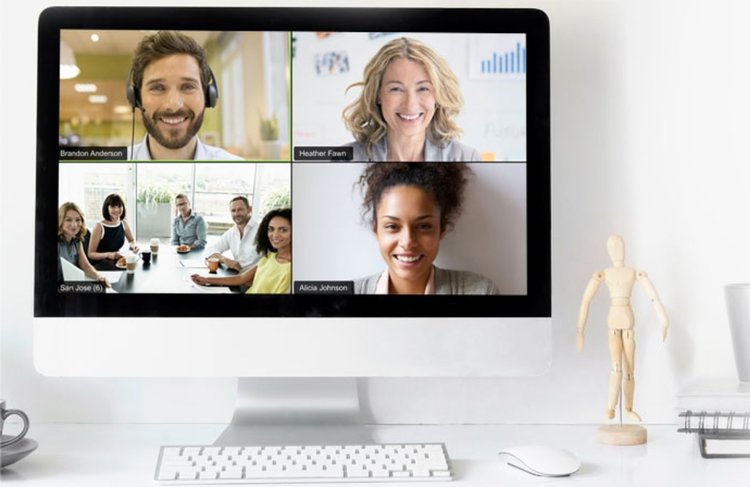
For teams with remote members, or that team member who is stuck at home from a “random ice blizzard” for the 10th time this month, you can still have engaging meetings that work the same as if you were all in the office. Zoom is a video conference platform that allows you to easily communicate with people across different locations. You can easily share screens with participants and co-annotate to allow for interactions between everyone.
A platform that can’t be forgotten when talking about online collaboration tools. From sharing documents on google drive to Gmail and Calendar, this cloud based collaboration tool allows people to easily work on projects together. From high school project to a company’s RFP document, everyone can benefit from the features of G Suite. Need a way to organize and centralize your tools including G Suite? Check out Happeo!

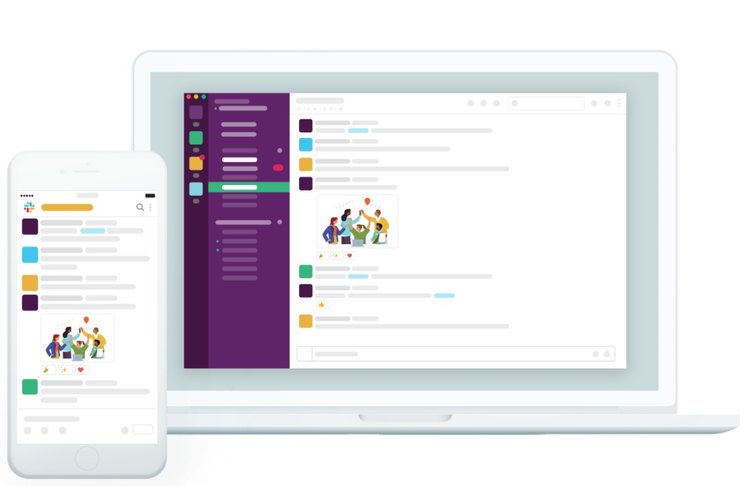
You are sitting at your desk and realize that you need some ideas on a hilarious joke you are going to tell in the next podcast. This is obviously a really important task that you want your team to help you on but probably not too time sensitive. Best way to handle this – put it in the #random Slack channel. Maybe even attach your google docs file in the message so that everyone can truly understand your goals for the podcast. With organized conversations and a variety of integrations, Slack has become a must-have collaboration tool for fast-moving teams.
The way team members work together to collaborate can always be improved. For this reason, feedback is critical. Through continuous performance management, 15Five helps to increase employee performance, engagement, and the ability to improve collaboration with one another.
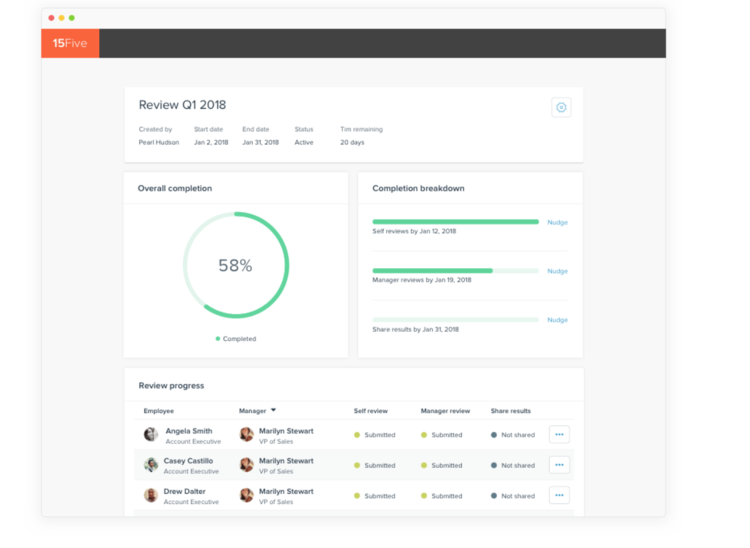

Meeting goals are kind of important. Asana is a platform which helps teams to map out projects, visualize the progress, and ensure a project is set to be met on time. Oh and, of course, Asana integrates with our most important tools like Slack and G Suite.
Tools changing the way we collaborate
We all want to improve the way we collaborate as a team. While the five collaboration tools above cover the bases, these five tools below are changing the way we think about team collaboration so that every team can be more effective, efficient, and equipped to succeed.
Probably the best invention since sliced bread (we are probably a bit biased). Cloverleaf cross-maps your team’s personality, skills, and culture, and reveals insights that can help you make better decisions about your teams. By understanding more about your team members, you can know how best to work with them and collaborate effectively as a team.


Sharing what you are working on with your team can have multiple benefits. Not only is everyone on the same page and motivated by understanding the strategy for how a goal is being accomplished, but by knowing what others are working can decrease inefficiencies in any overlap of work. Another exciting perk is that it becomes even easier to celebrate team success and recognize individuals. Who doesn’t enjoy a bit of celebration that encourages team collaboration?!
In group settings, we all have biases that can negatively impact how we work on a team. Balloonr is a platform that helps to gather anonymous ideas and feedback and then collaborate with them. Through Balloonr your team can collaborate more effectively by avoiding group dynamics, cognitive biases and fear of failure which can all result in time wasted, poor decisions and lack of innovation.

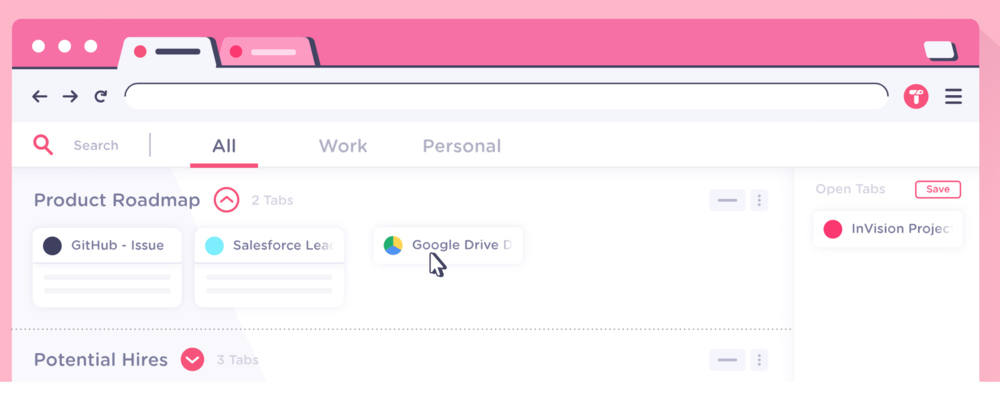
In today’s cloud based world, we all may have too many tabs open to count as we access multiple resources at a time. Toby allows you to share and organize resources into one collection. From centralizing team resources in one organized area to easily sharing all your working tabs, Toby helps make collaboration easier.
Whiteboards are helpful, but they don’t do it all and are especially not the best when your team isn’t all in one place. With Miro, your team can have a collaboration experience to create and centralize communication utilizing a variety of integrations.
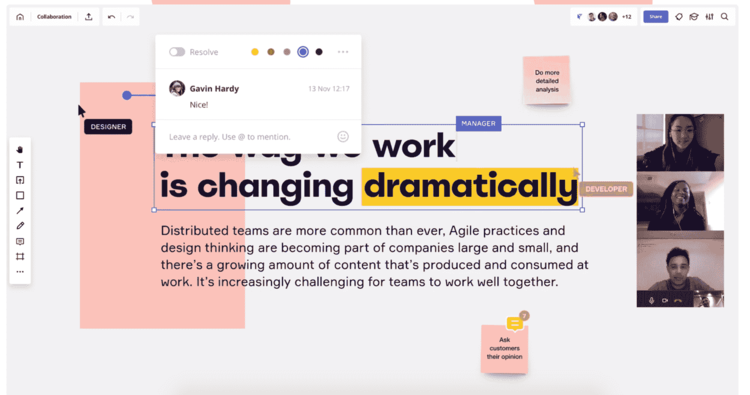
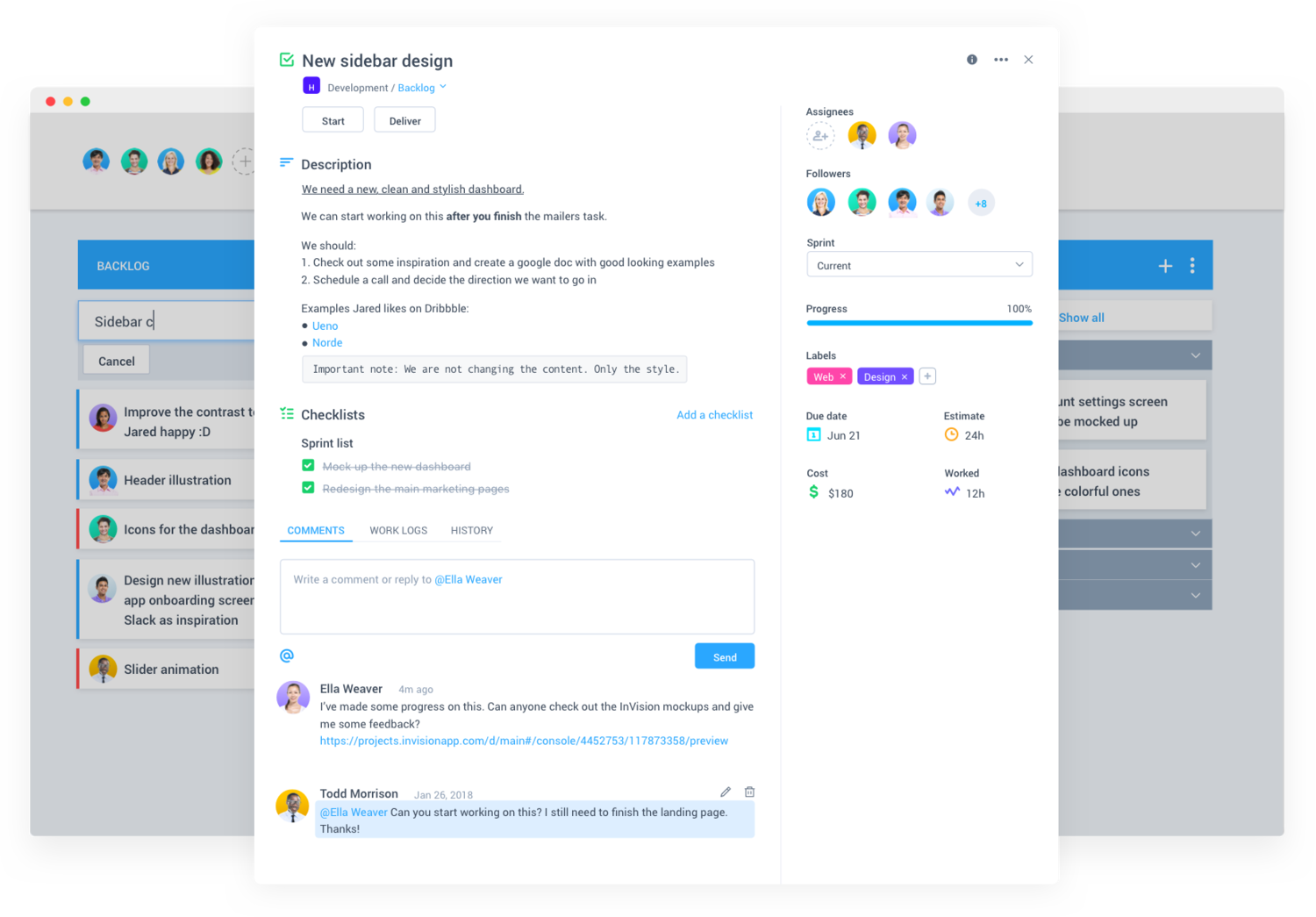
If you’re still communicating with your teammates and keeping track of project updates via email, you’re doing it wrong. Hubstaff Tasks is a project management platform that lets you easily organize your tasks and projects and streamline collaboration with your teammates. You can move tasks to different project phases by dragging and dropping, prioritize tasks more easily, and automate project workflows.
Team collaboration isn’t always easy. It can be difficult to work with certain team members or feel ineffective at times. As Aytekin Tank explains, to both foster effective collaboration and eliminate unnecessary collaboration “make it easier for people to act autonomously by encouraging all staff to leverage resource-sharing technologies.” By combining the right tools, you can begin to set your team up for success to help them do better work.
Learn more about the Cloverleaf integrations here to have more engaged and cohesive teams.

